In 2022, NIO and Xpeng have successfully released their flagship SUVs under the challenge of the pandemic. Among the top three new powerhouses, only XPeng G9 still remains partially undisclosed. On August 10th, the official XPeng announced the G9’s interior design and some important features, officially starting pre-sale.
Although G9 is the latest of the top three new powerhouses, its interior is still the most anticipated one.
In the arms race of assisted driving, we have seen the trend and outcome. However, there has not been a “standard answer” in the development of the cockpit. Xpeng’s P7’s stunning voice experience and P5’s breakthrough attempt have become a beacon for the entire industry. We also look forward to G9’s cockpit bringing us some fresh blood.
This article will be divided into two parts. The first part will focus on analyzing the interior characteristics of G9, and the second part will review all the known information about G9 so far.
Luxury + intelligence? What does XPeng G9’s interior want to convey?
Design
When P7 first came out, the most criticized aspect was the lack of luxury in the interior. Obviously, G9 has greatly improved in luxury compared to P7. However, compared to the same level of NIO ES6 and Avita 11, it is still slightly inferior. We also look forward to the final effect of other interior colors.
In terms of design, G9 has made iterative optimizations based on P7, with a new design for the previously criticized steering wheel and wireless charging for mobile phones.
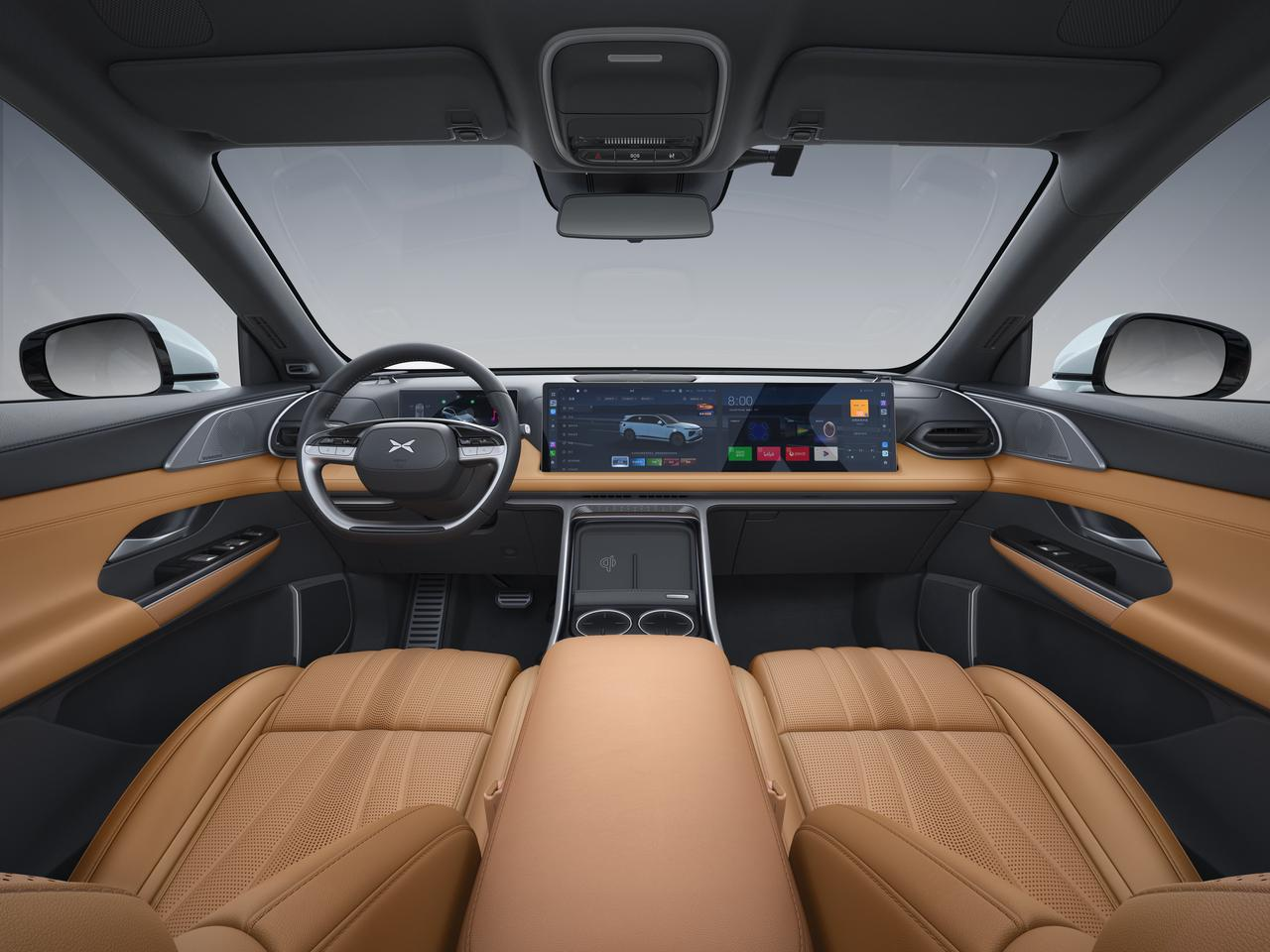


As for the steering wheel part, G9 still uses the same two-color design as P7, black and silver, but the steering wheel buttons have been redesigned with a button + roller design, combining the strengths of P7 and P5. From the currently exposed spy photos, the redesigned P7 will also use the same design.On the left side of the steering wheel is the auxiliary driving speed control roller, with the car distance adjustment button on both sides. Below that are the voice button and multi-function button, and it is expected that the new steering wheel will have a better experience of auxiliary driving speed control.
On the right side of the steering wheel is the volume control roller, with multimedia playback control buttons on both sides. Below that are the return button and mute button.
Additionally, it is visible to the naked eye that the overall thickness of the G9 steering wheel compared to the P7 has increased significantly. It is expected that this will provide a fuller grip compared to the P7, and the steering wheel is made of perforated leather.
Unfortunately, such a steering wheel in this brown interior design still feels like it lacks a bit of “luxury.”
In terms of functionality, the G9 steering wheel supports 4-way electric adjustment in front, rear, up, and down, and is also linked to the seat memory function, which can automatically adjust the steering wheel position according to the driver’s settings.
10.25 Inches + Dual 14.96 Inches + Snapdragon 8155
First, let’s take a look at the hardware of the car system:
- Instrument panel 10.25 inches resolution 1920*720
- Control panel 14.96 inches resolution 2400*1200
- Co-pilot panel 14.96 inches resolution 2400*1200
- Snapdragon 8155 chip
Instrument Panel
In terms of the instrument panel, the G9 has the same size as the P7. However, like the P7, the instrument panel and the center control copilot screen are not on the same horizontal plane.
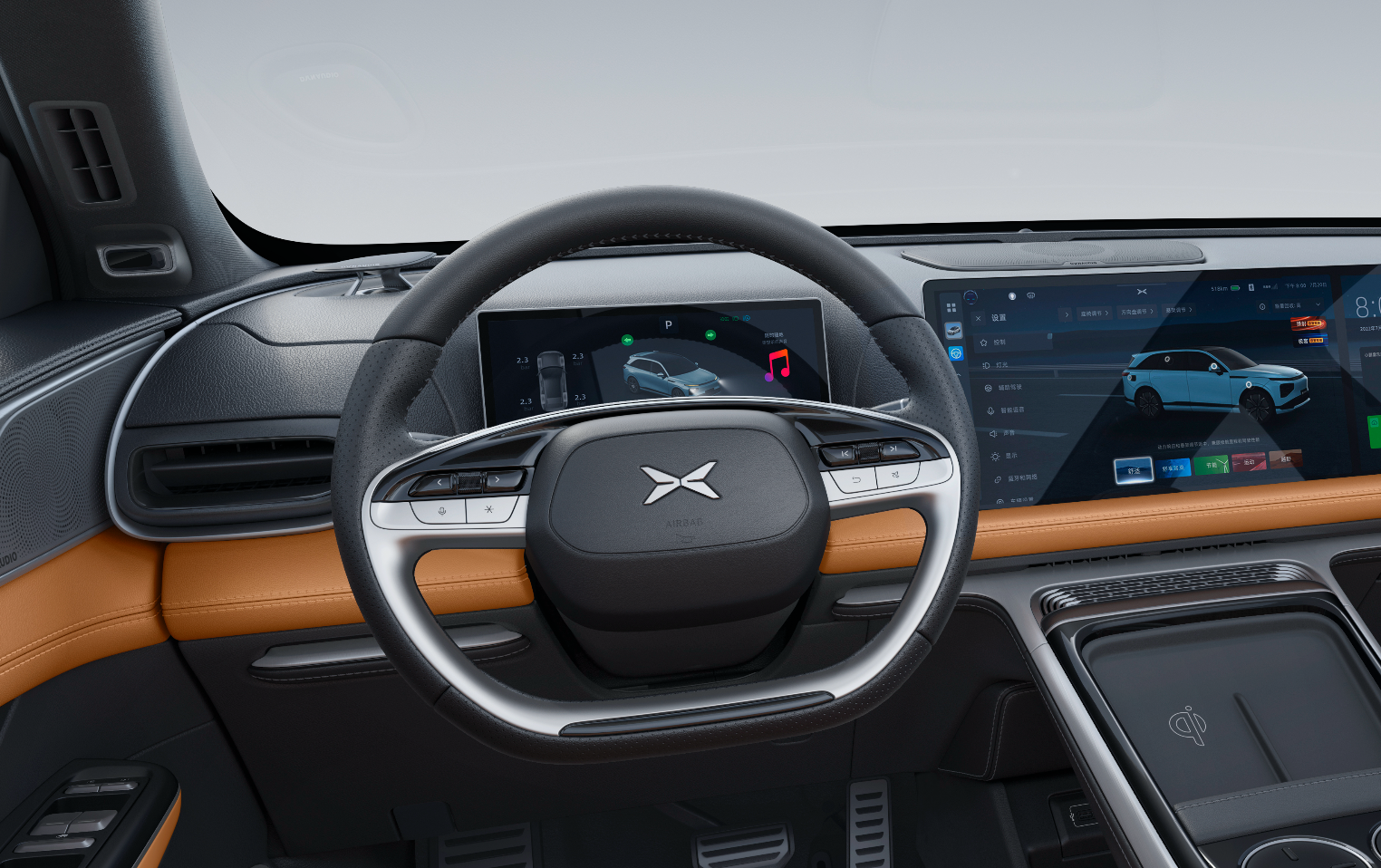
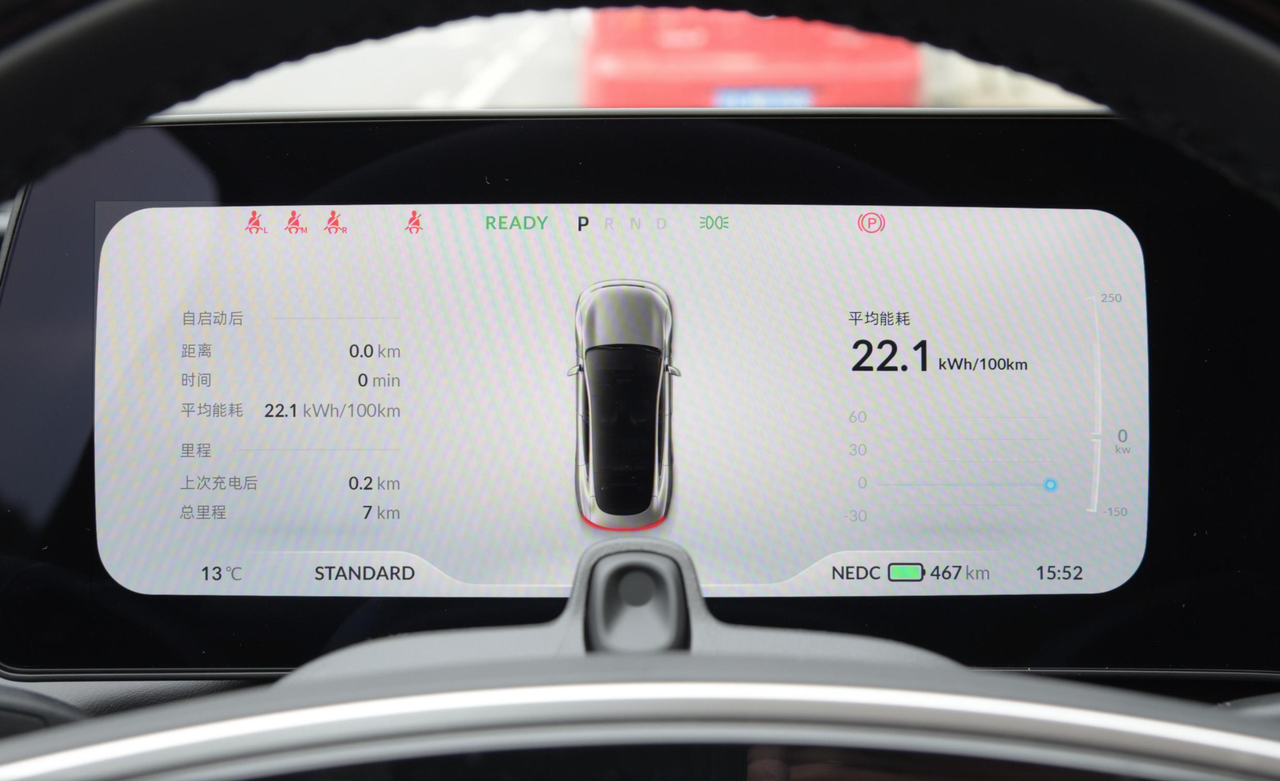
The more rearward instrument panel can avoid the steering wheel obstruction, which is a new problem in the “large screen era.”

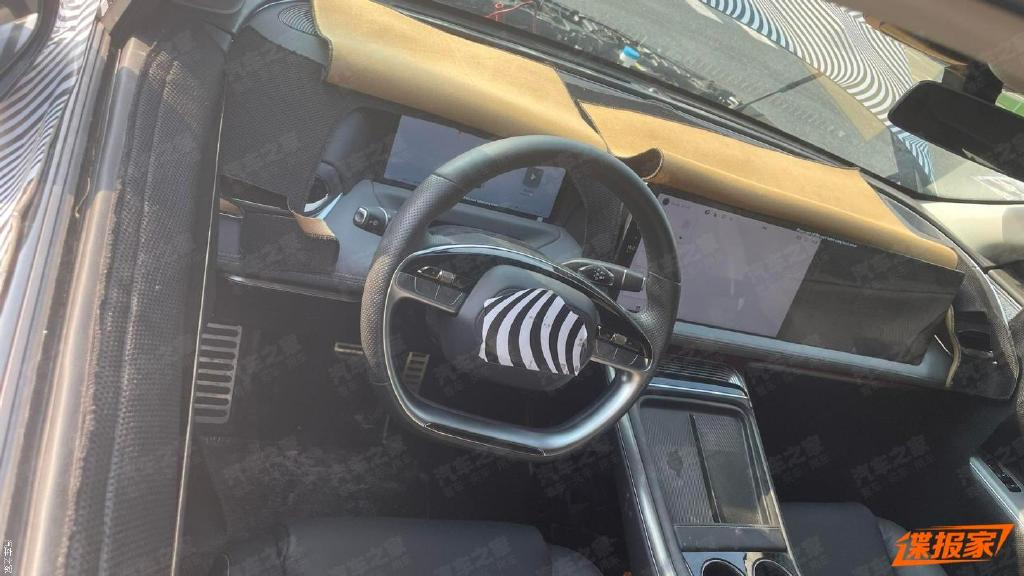
In terms of content layout, the G9 continues the design of the P7, with various types of information such as navigation, traveling, energy consumption, vehicle condition, and multimedia that can be set on both sides. You can combine them according to your own needs, and the middle area shows the visualization and speed display.
From the experience of using the P7, Xpeng’s information display is very detailed, and the custom space is large enough, allowing you to set up commonly used features such as energy consumption and navigation. Just relying on the instrument panel can convey the required information during driving.#### Center Console Screen
There are some changes in UI compared to P7, but based solely on the current rendering images, we are not yet able to make a complete evaluation, which will also wait until the static experience stage to bring you more detailed sharing.
The size of the G9 center console screen is the same as P7, and the resolution is also 2400*1200. The material is still LCD.
In terms of details, it can be seen that the screen-to-body ratio of the XPeng G9 instrument screen is very high, which has greatly improved compared to the large black edges of the P7.

In terms of UI, the overall layout is similar to P7. The map is the default desktop of the car, the left side is the resident Dock bar, the 6 icons cover the most commonly used functions in the car process, and the middle is the air conditioning setting.
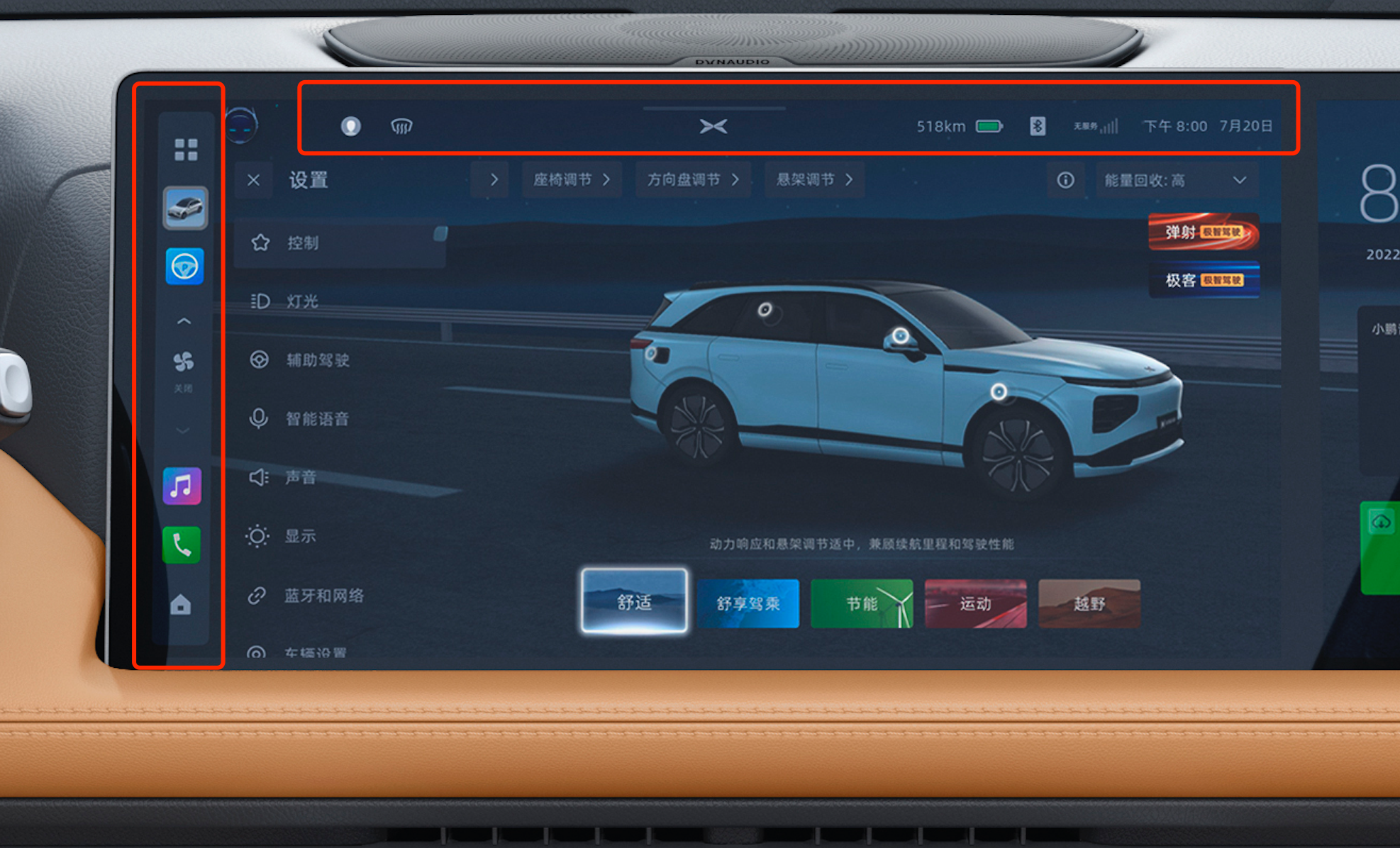
In the middle, there is a multitasking window displayed in a card form, which can be used to view multimedia information while using navigation.
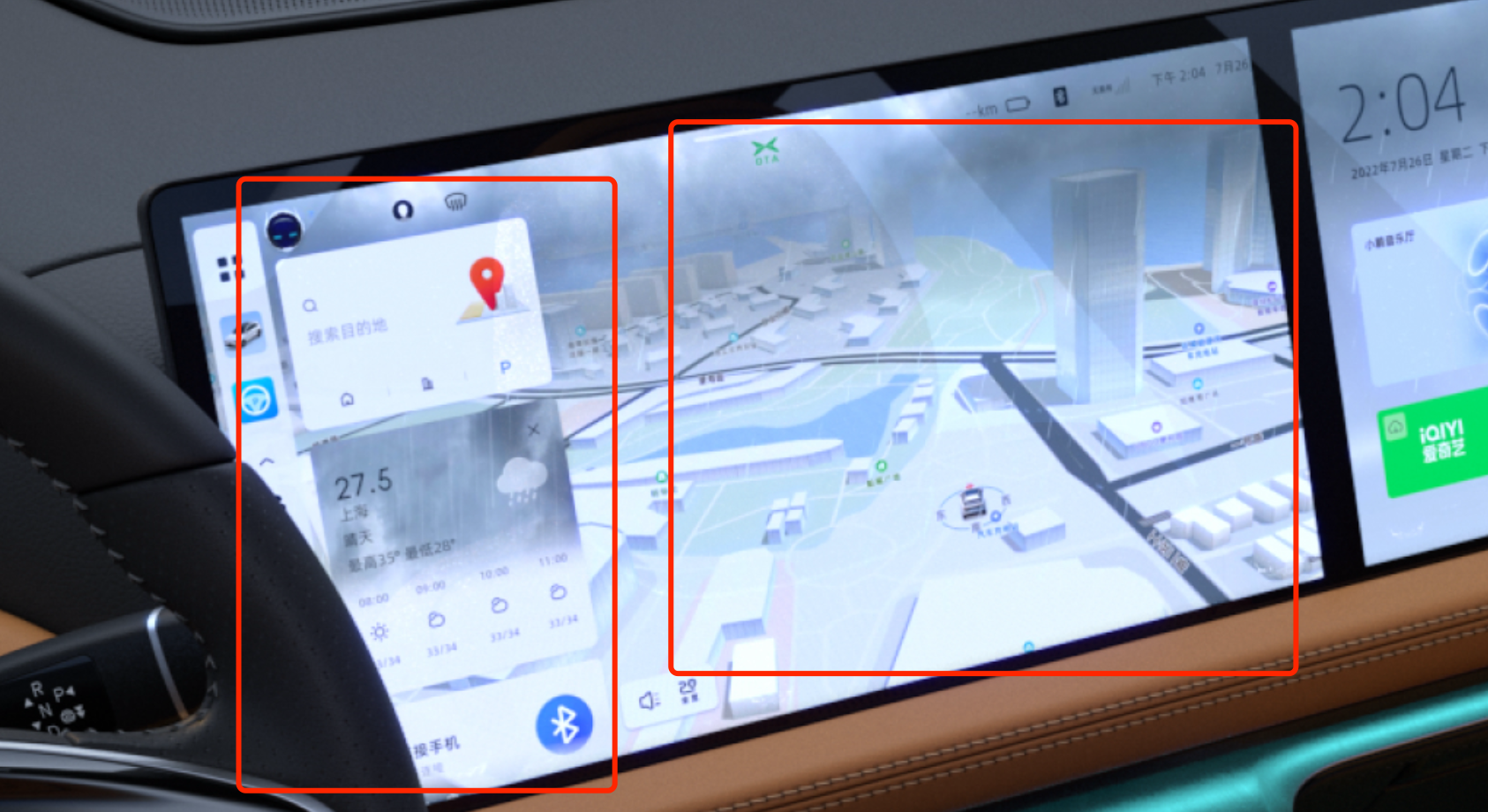
On the right is the function display area, and the default navigation is the bottom layer desktop.
The top layer displays basic time and range information.
This set of interface layout has been a more practical scheme on P7, so the adoption on G9 can ensure the basic user experience.
However, it should be pointed out that compared to P7, G9’s UI feels overly designed in some aspects, such as the various colored icons in the left Dock bar, and the multiple colors of the right and bottom modes, which make the entire interface appear a bit confusing. We hope to optimize it to be more concise during mass production and delivery.
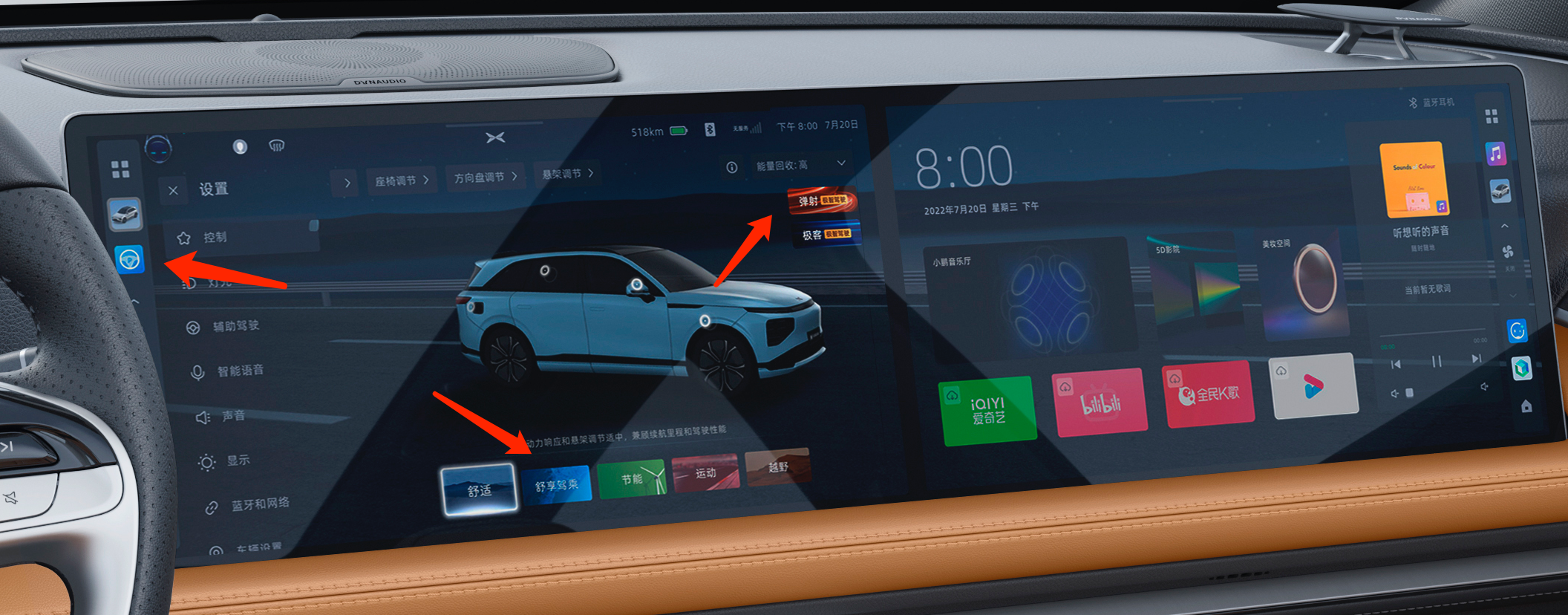
Finally, here are 2 details about the car’s machine:
- On P7, XPeng has 2 setting entrances, one for vehicle settings, adjusting ADAS, driving mode, etc.; the other for machine settings, adjusting brightness, display color, etc. For users, the two settings are not conducive to finding functions during use, and will often result in searching for a long time in the vehicle settings and finding out that it is in the system settings . But in G9’s rendering image, it can be seen that XPeng has already integrated the 2 settings.
2. The central control panel and instrument panel size and resolution of G9 and P7 are identical. For Xpeng, this means that only one set of UI design needs to be created, which can then be shared by both P7 and G9, greatly improving the efficiency of the software department. As a P7 owner, I also hope to use this set of UI as soon as possible.
Co-pilot screen
The co-pilot screen size and resolution of G9 are the same as the central control panel, both 14.96 inches and 2400*1200.
The co-pilot screen is a function that received high praise from users after the launch of Ideal ONE. After Ideal ONE, many car companies began adding co-pilot screens, but in many models, due to compromise in interior design, only a very small screen can be used. On the G9, this screen is not only large in size but also relatively close to the co-pilot, so the convenience of click operations is better than that of vehicles using small screens.
After zooming in on the dual-screen part, it is clear to see that there is a black edge between the dual screens, and they are not a complete screen, but the screen border is very narrow, which is highly praised.

In terms of UI, we can see that Xpeng has made different APPs into card-like large icons similar to smart TVs for easy interaction. At the same time, music is made into a form similar to small components on the right side. In addition, like Ideal L9, the co-pilot screen can connect to Bluetooth headphones to achieve different songs being played simultaneously by the driver and co-pilot.
Now, let’s take a look at what the G9’s competitors’ interiors look like.
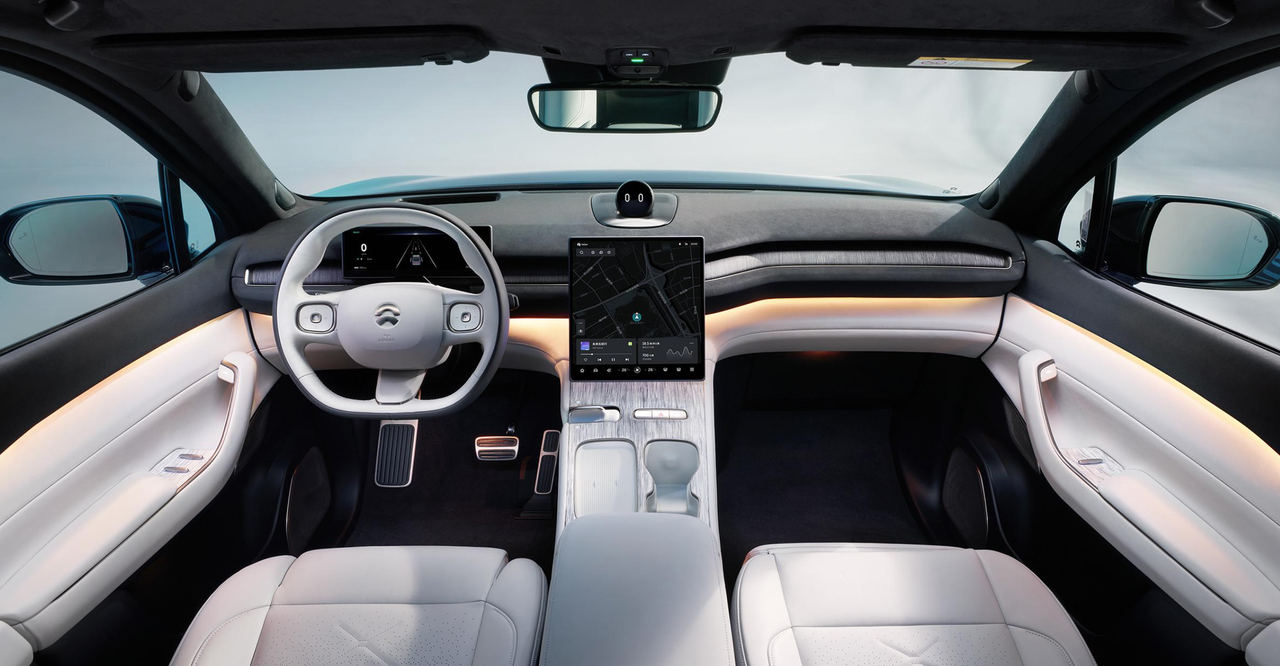
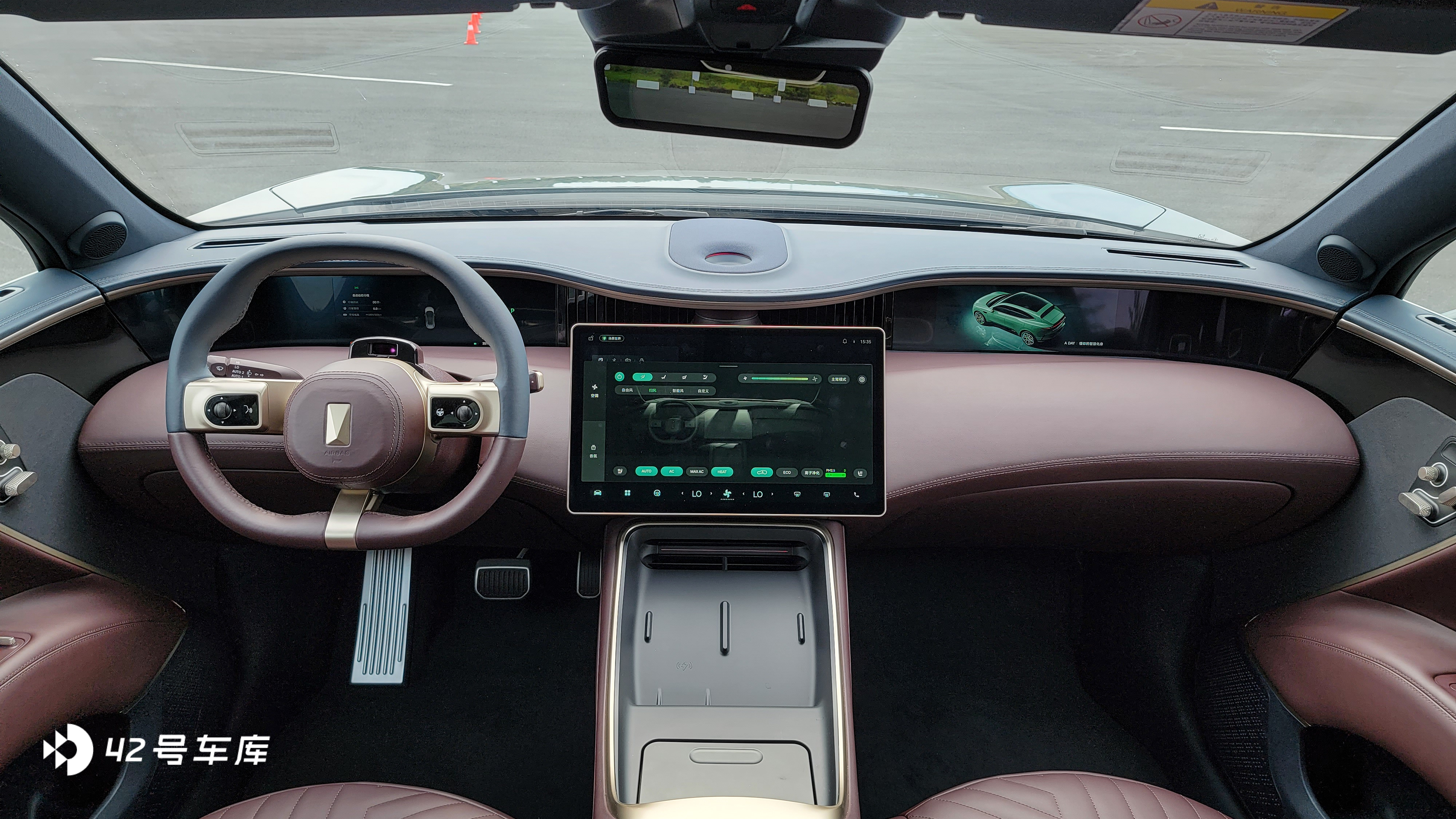
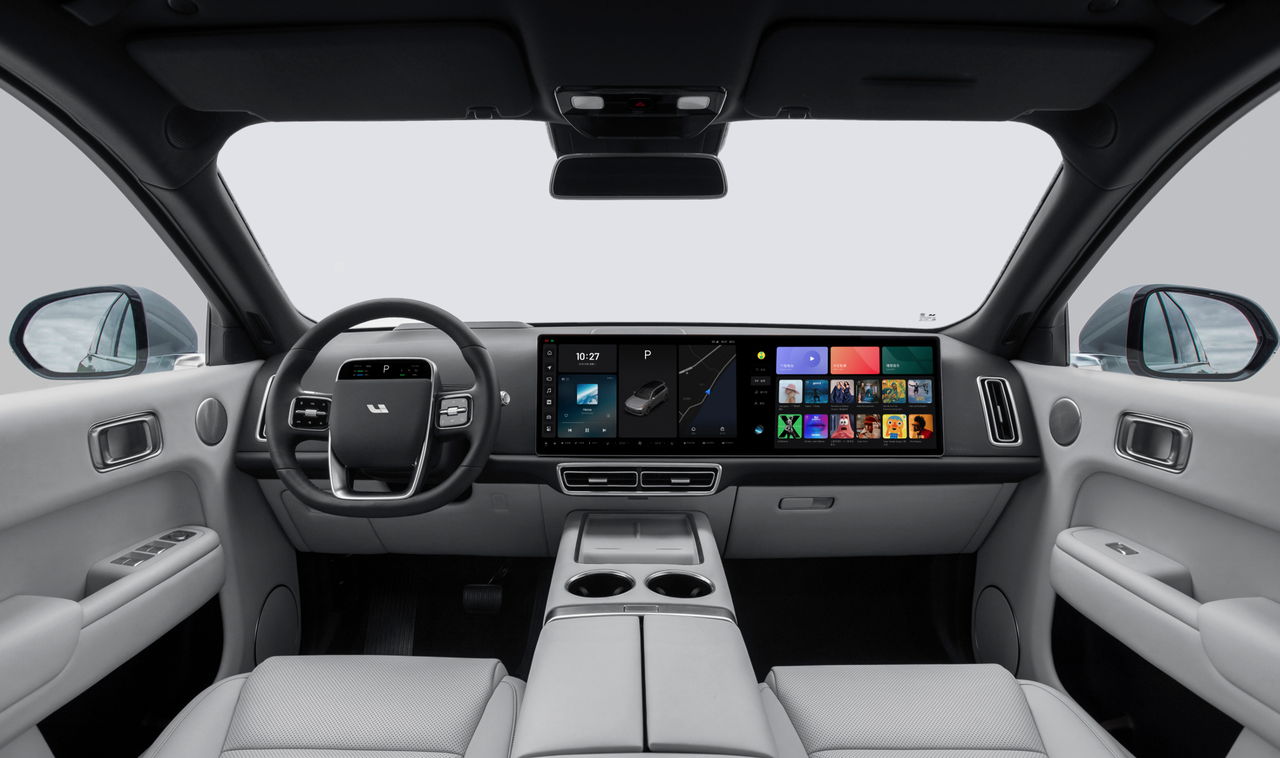
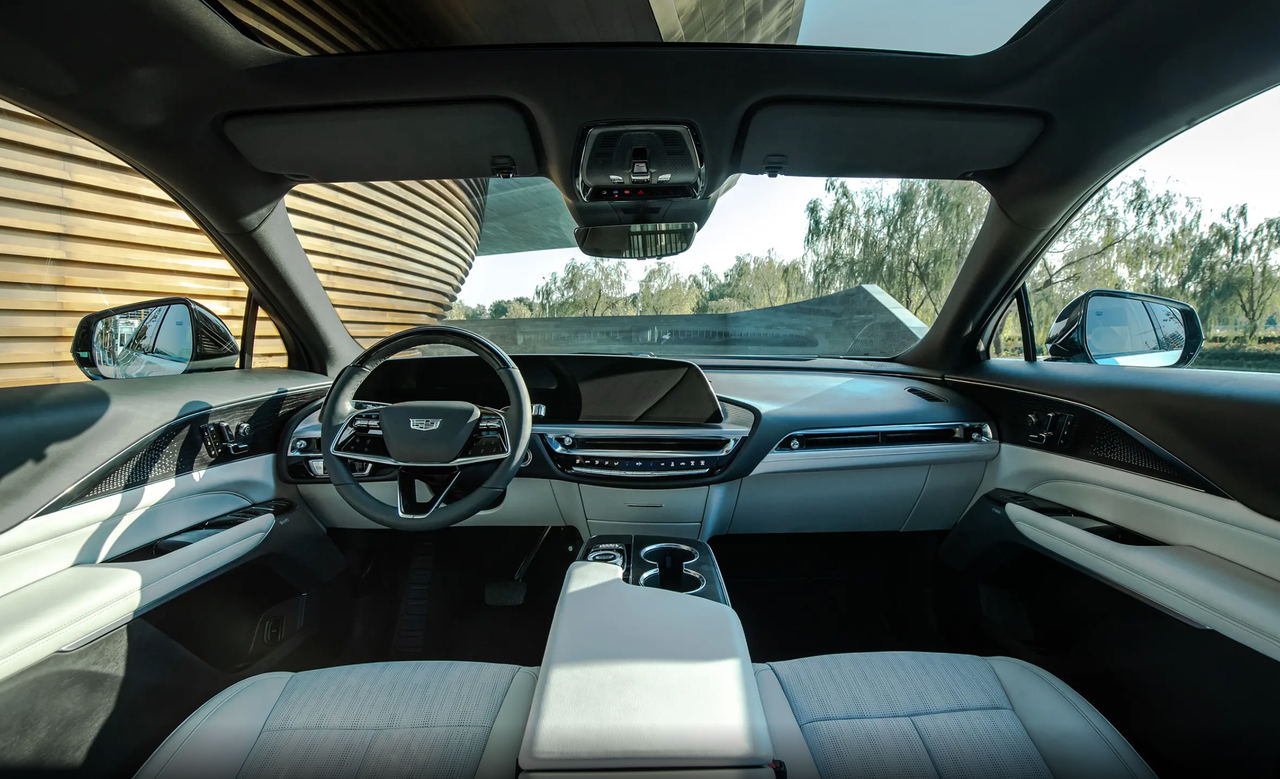
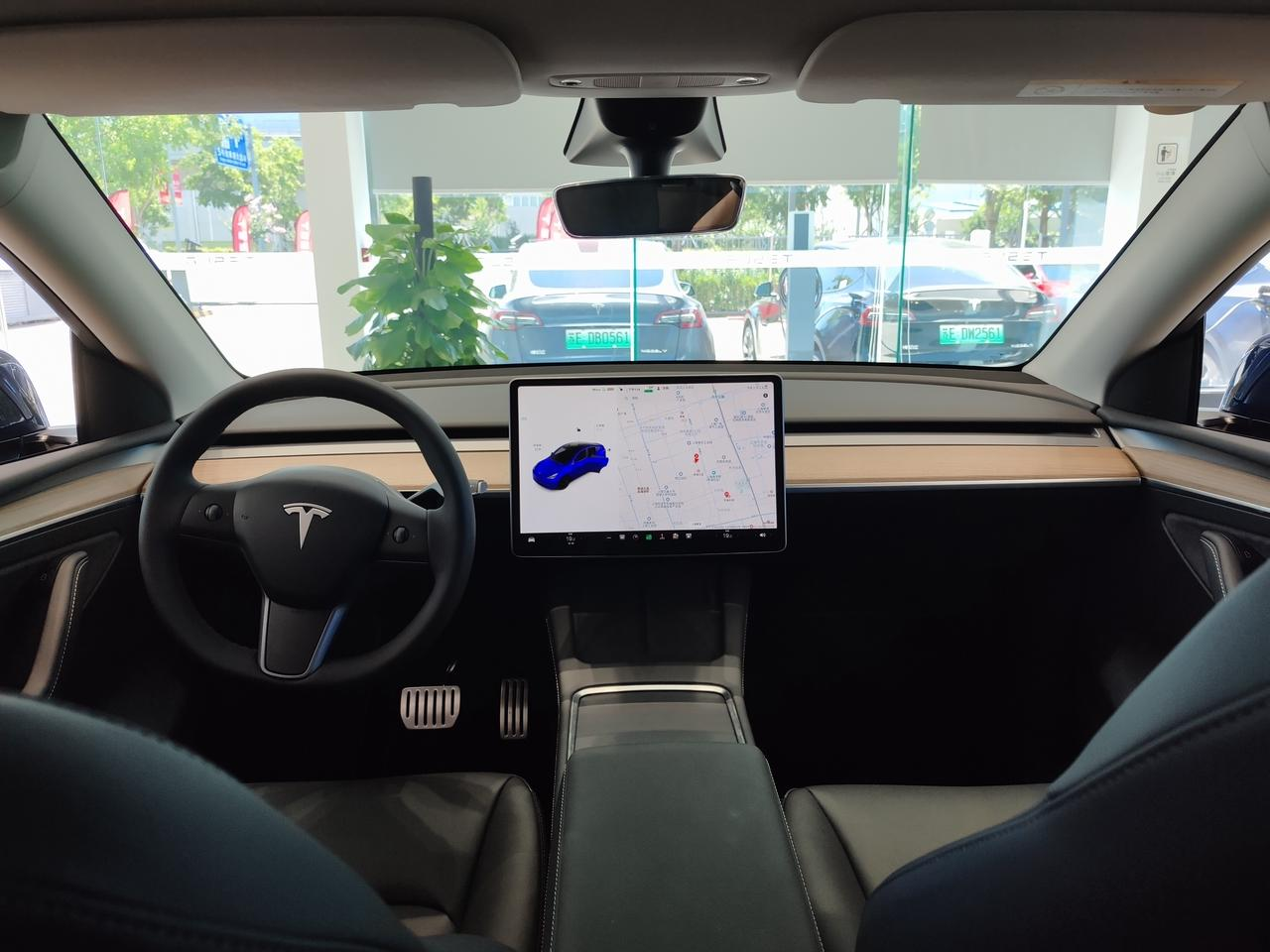
Compared to SUVs of the same level, Xpeng G9 has become the car model with the highest “screen-to-control panel area ratio” in the front row due to its three screens.
Voice upgrade?
From Xpeng’s official introduction, we learned that thanks to the larger computing power of the 8155 chip, the voice capability of G9 has been improved once again.
Fast conversationAt present, the voice assistant we use requires a delay of 1.5-2 seconds from sending the command to the system executing it. During this 1.5 seconds, the system needs to recognize, understand, and finally execute the command. However, it is precisely this delay of about 1.5 seconds that often causes people who are not used to using voice assistants to be out of sync with the assistant, making them feel that the voice assistant is not very useful.
On the G9, XPeng’s goal is to achieve millimeter-level response, that is, “doing what you say”.
Parallel Commands
This means that you can issue multiple commands at the same time during a conversation, and the system can execute them simultaneously, improving interaction efficiency.
Local Conversation
Current voice systems require network support, and often encounter situations where voice cannot be used in underground parking lots or mountainous areas due to poor signal. However, G9 can realize voice control of the vehicle in the absence or weak network status.
Four Sound Zones
This is a more understandable concept and is already available on the market. XPeng’s voice assistant can pick up sound from all four seats in the front and rear of the car during voice interaction, achieving sound source orientation and separation, and passengers in other sound zones will not be disturbed.
Unignorable Seats
As a car, the comfort of the seats is the most basic, but this is generally not outstanding in the first batch of new energy vehicle models. We experienced a significant improvement in seat comfort on second-generation models such as the NIO ET7 and LI L9.
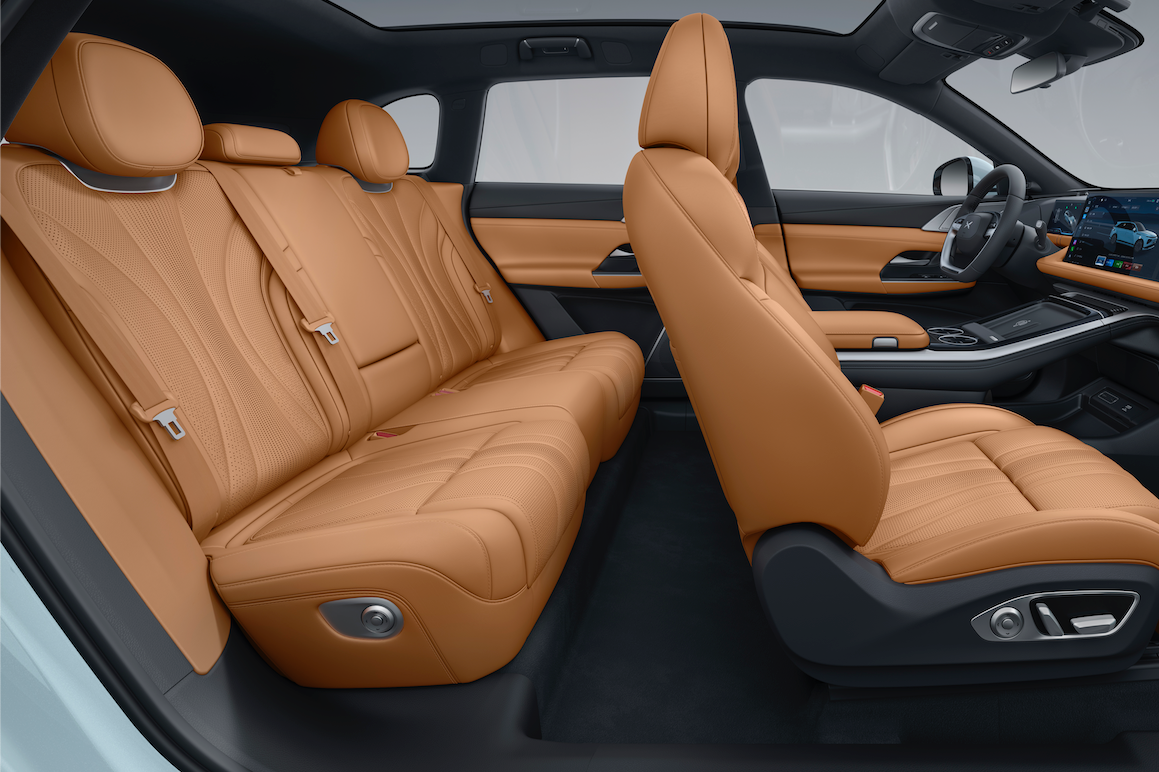
The seats on the G9 have also been improved compared to the P7. In terms of functionality, the front seats support heating, ventilation, massage, and beat.
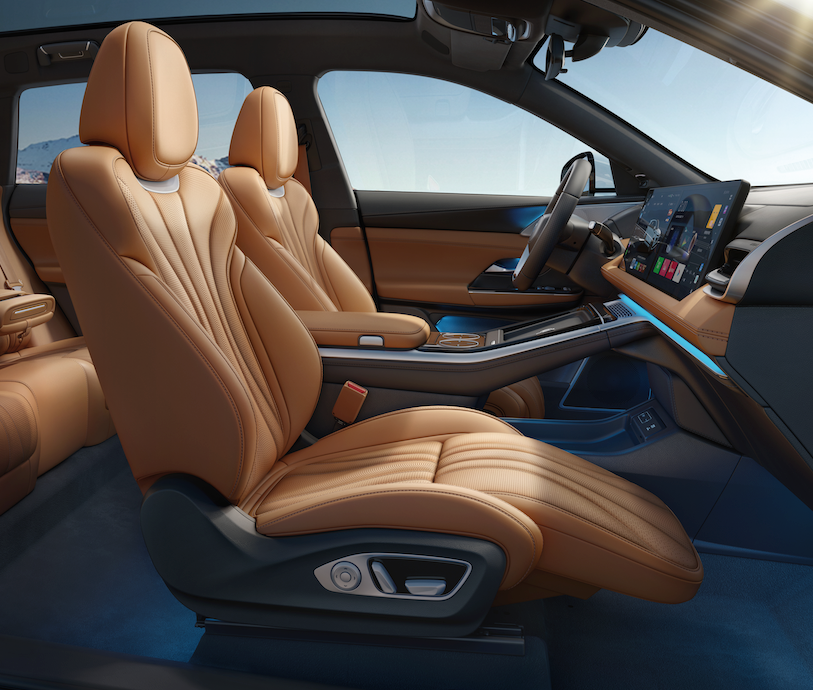
The front passenger seat has added an electric calf support.
If we zoom in on the rear door panel, we can see that the G9 has added a rear seat angle adjustment button on the door panel control button compared to the P7. In terms of functionality, the rear seat supports heating and massage, and the backrest angle can be adjusted from 27°-37°.
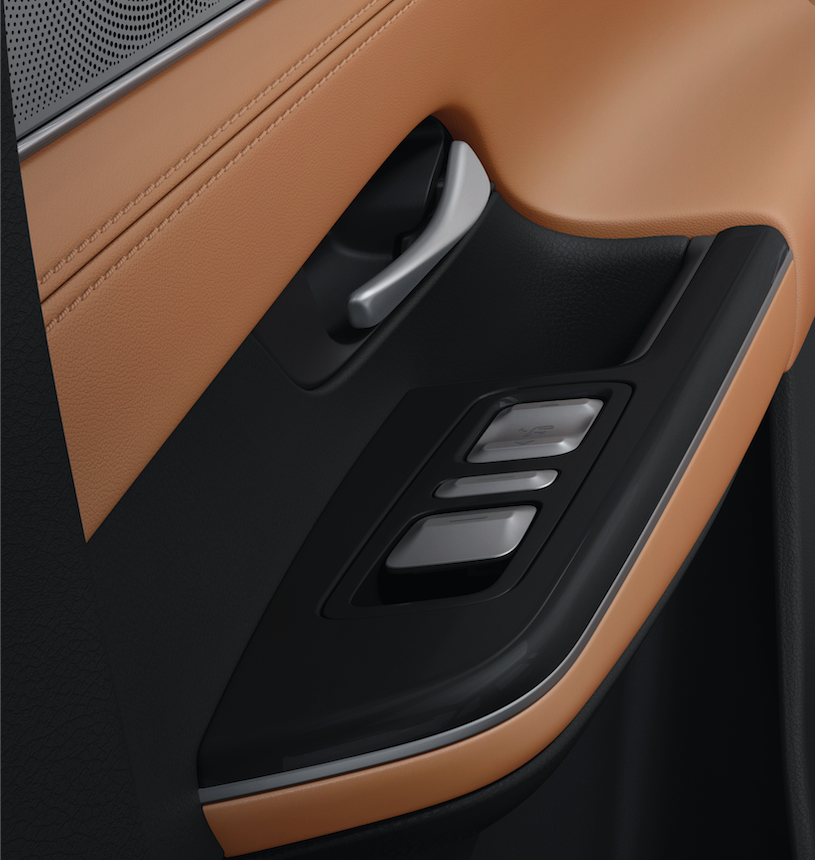
In addition, G9’s rear seat comes with elephant-nose-shaped thigh support. As can be seen from the figure, there is a significant extension in the center of the cushion, which provides better support for the thighs.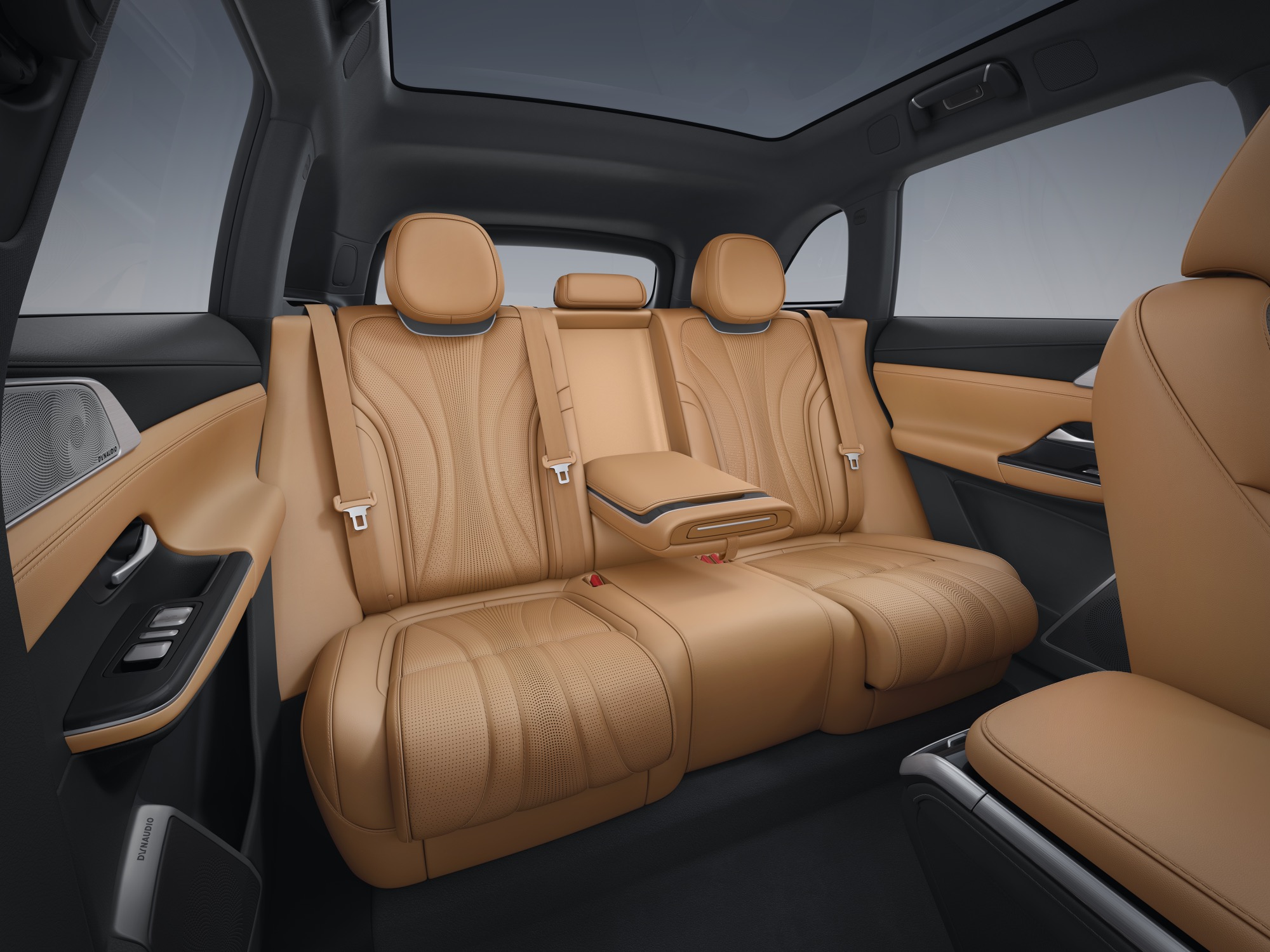
Moreover, based on this design, G9 also supports the feature of expanding the trunk space by folding down the rear seats.

In terms of the legroom in the back seats, based on our actual ride experience, G9 is as good as AVITA 11, but slightly worse than NIO ES7.
Xpeng Music Salon
In our previous article, we mentioned that before realizing fully automated driving, all of the driver’s attention must be on driving tasks, and the only thing that can be enjoyed while driving is the sound. Therefore, the sound system has become a new breakthrough point for new energy vehicle cabins.
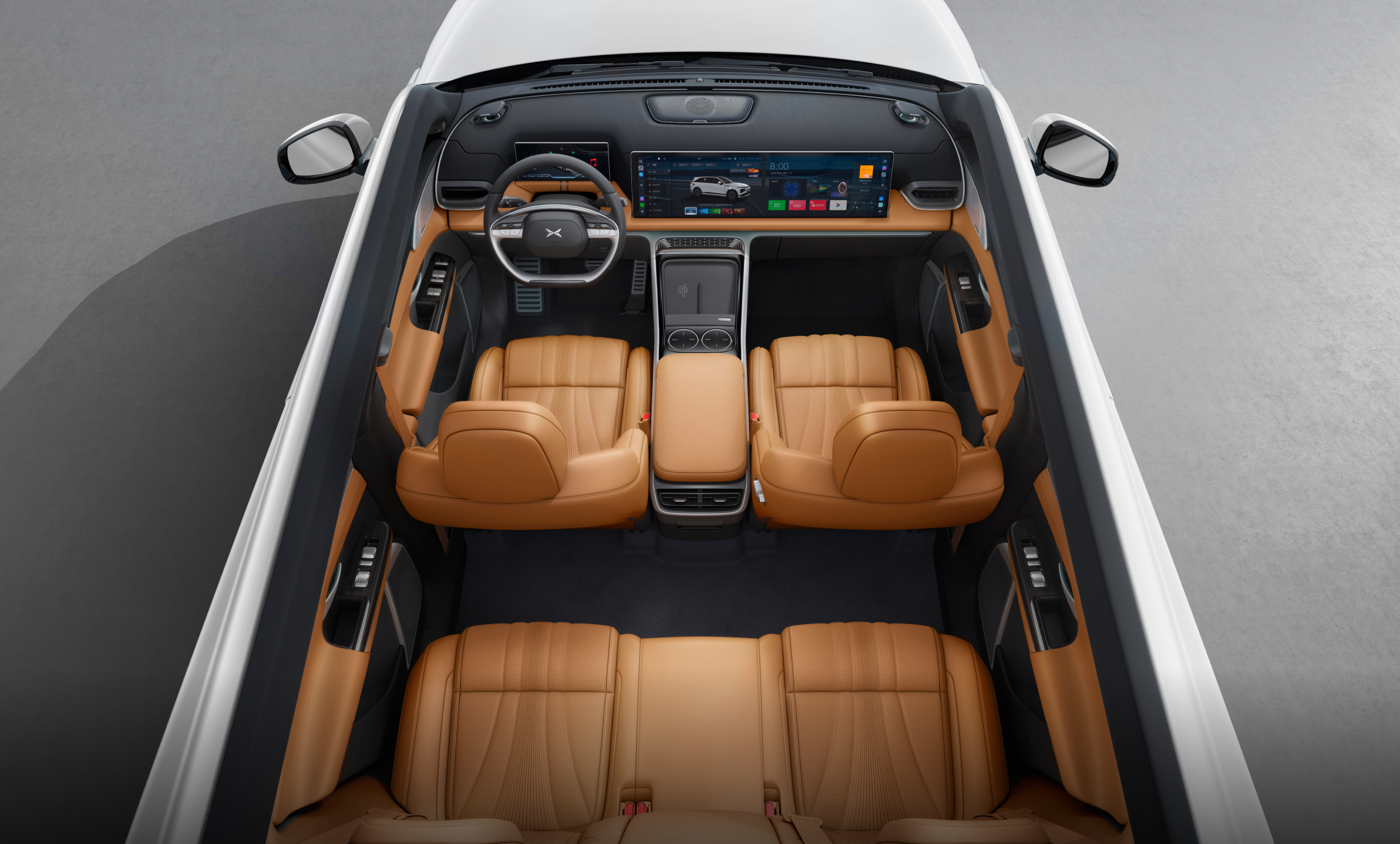
The sound system in G9 is made up of 28 acoustic units and has a maximum power of 2,250 watts, which can achieve a 7.1.4 multi-channel music system and uses Dolby panoramic sound technology.
When the backrest of the rear seats is lifted, the sky channel speaker of the sound system can be seen.

In addition, the upgraded version 2.0 of the headrest speakers, which were also present in the P7, have now been installed.
Previously, Xpeng frequently mentioned the concept of 5D, and this time we finally experienced Xpeng’s 5D music cabin. Based on the sound system, Xpeng adds a linkage between the air conditioning, aroma, and seat.
The system will automatically adjust the air conditioning wind, aroma, and seat tilt angle based on the content of the movie, to achieve a more immersive audio-visual experience.
However, it is necessary to have movie sources that are compatible with this system, and based on our understanding, Xpeng is in discussions with iQiyi to promote this feature. Under normal circumstances, the movie will be adapted accordingly.
Other Details
Car Power
There are two phone placement areas on the central console, and the area on the left with the “QI” logo supports wireless charging with a power output of 15 watts. The area on the right does not support wireless charging and only provides a slot to place the phone.In the hollow storage compartment below the center console, there is a USB A and a Type-C charging port. The USB A supports a maximum of 2.4 A charging, while the Type-C supports 60 W power supply and can power some lightweight laptops to meet the needs of some office workers. Next to it, the 12V cigarette lighter has a maximum power supply capacity of 180 W.
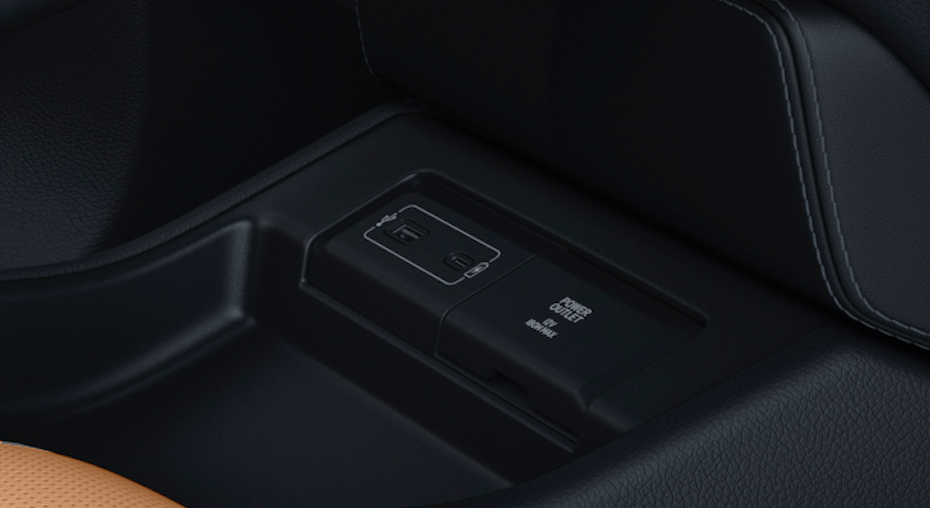
Air Conditioning System
The air outlet of the G9’s front air conditioning is composed of three parts. The left and right sides are conventional air outlets, but adjusting the air volume and speed requires adjustment through the car’s on-board computer.
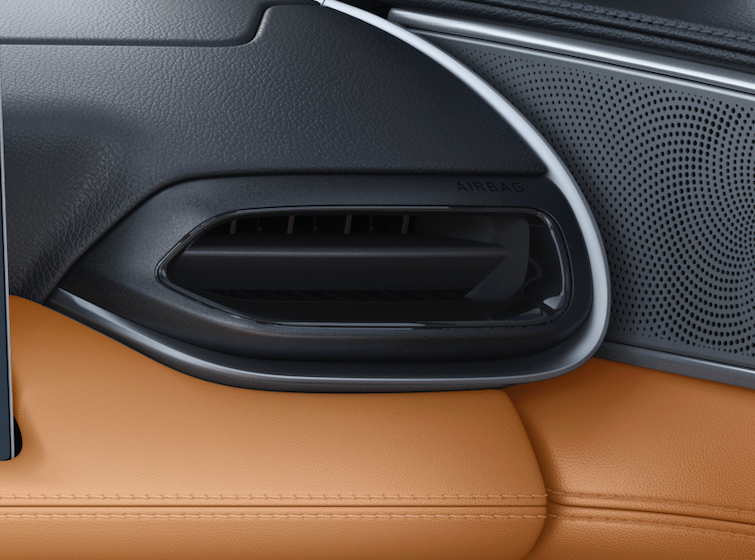
Due to the fact that most of the central control area is occupied by the screen, the air conditioning outlet is compressed very narrow. We are looking forward to the actual air outlet experience and cooling and heating efficiency.
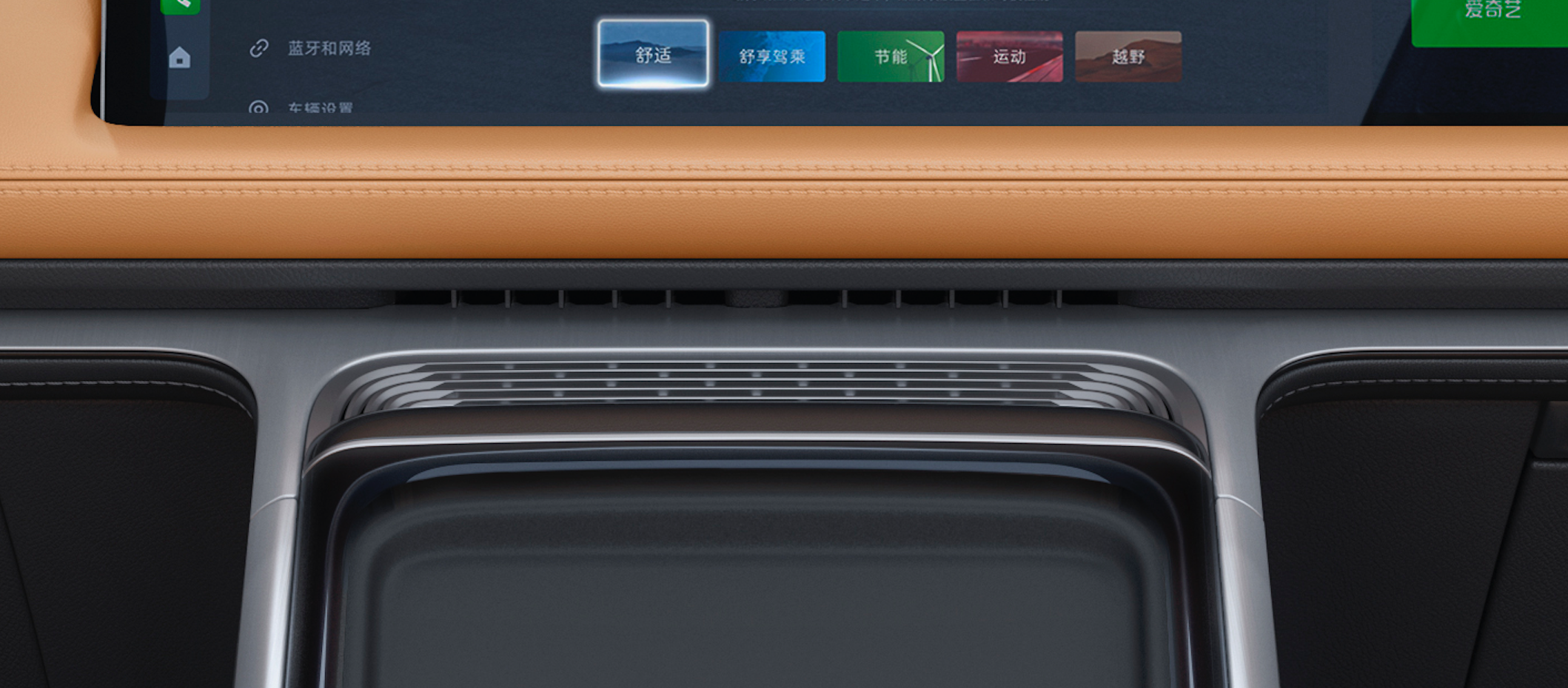
Roof Glasses Box
There is an area above the top rearview mirror that can be opened as a glasses box. It is such a pleasure for P7 owners who can only put their glasses in the armrest box.

So far, we have finished interpreting the interior of the Little Xpeng G9. After establishing a certain understanding of the appearance and interior of the ultramodern Xpeng G9, let us now explore the core technologies of the car. Xpeng is a new force in the domestic automobile industry that has pioneered core technology self-research, and the G9 is the highest-priced model launched by Xpeng since its inception. Therefore, what breakthrough technologies it has become the most concerning issues for users.
First to Debut, Last to Launch
The Little Xpeng G9 officially debuted at the Guangzhou Auto Show in November last year. As the flagship SUV among Li, Weipeng, and Xpeng, the G9 naturally became the star model of that year’s Auto Show. Among the top three new forces, the Little Xpeng G9 was the first to debut as a flagship SUV but became the last model to be launched.
Design is the Ticket of a Flagship Vehicle
As a newly established brand, one of the most basic requirements is that the design style cannot challenge the public’s aesthetics. For the exterior, consumers have veto power.
G9’s exterior design continues X peng X Robot Face’s family-style design. Since it has been released for a long time, we will not elaborate on the exterior design.According to the feedback from users after its appearance, most people accept G9’s exterior design, and many users have also given positive feedback on community platforms.
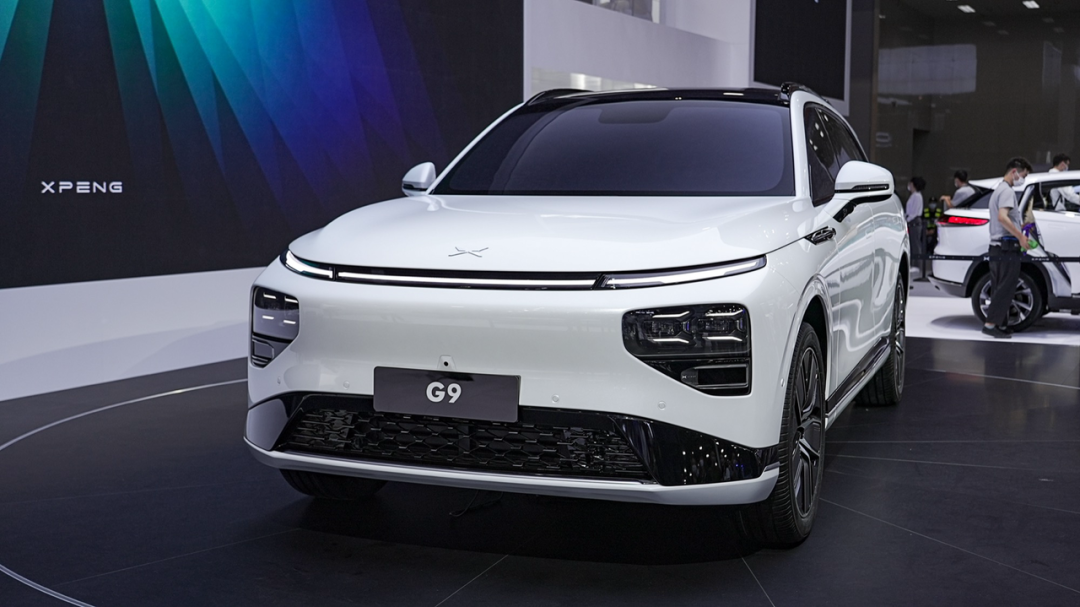
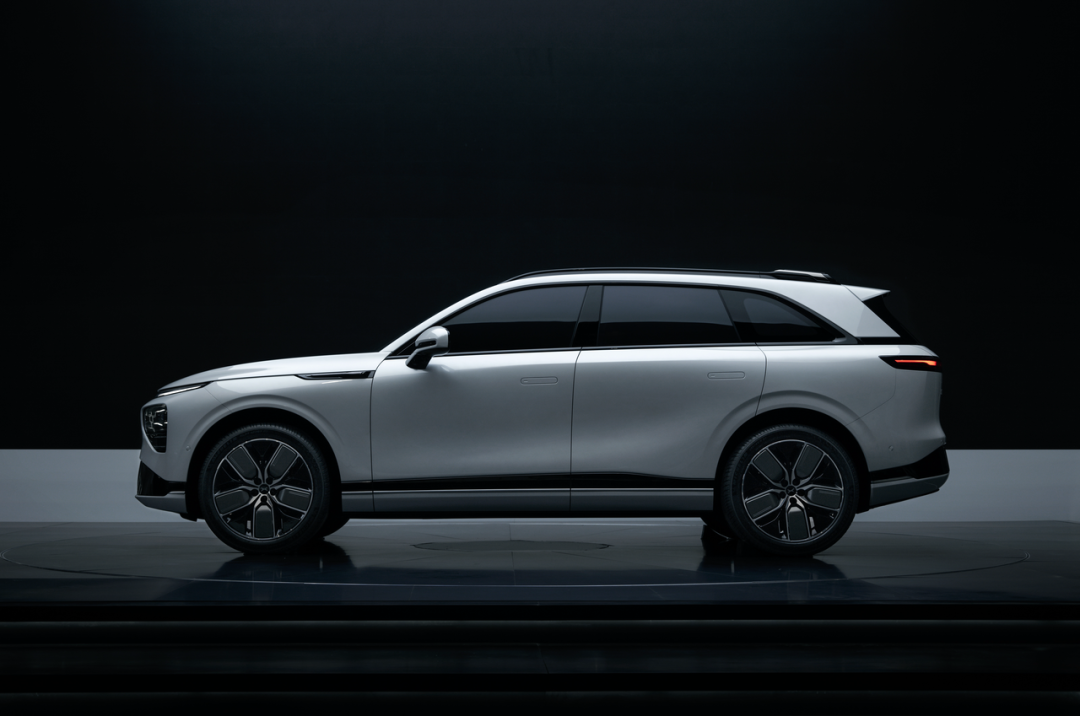
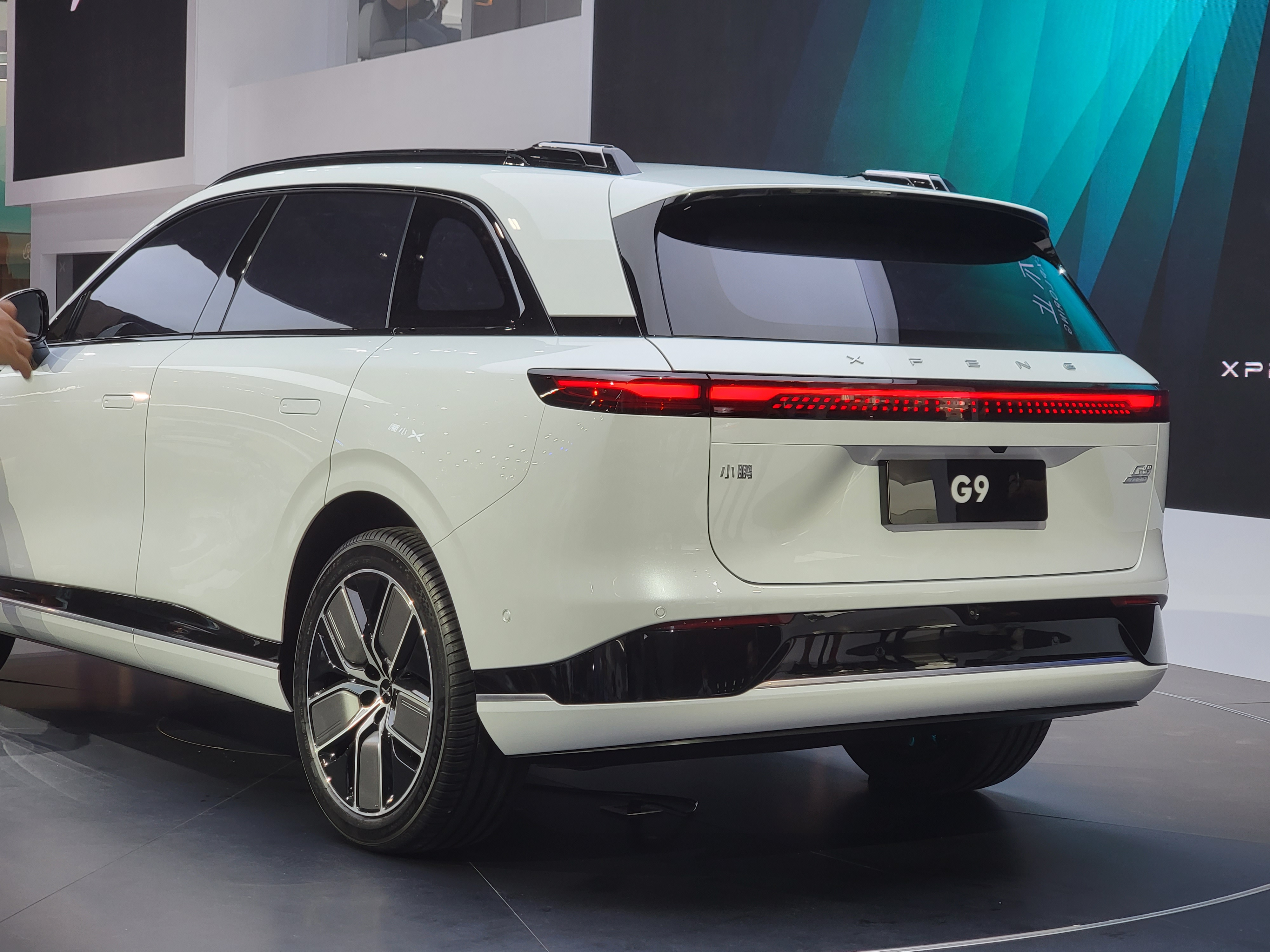
Here we can also compare G9 with other medium and large SUVs that are about to be delivered, and it is clear who is more exquisite and has more temperament.

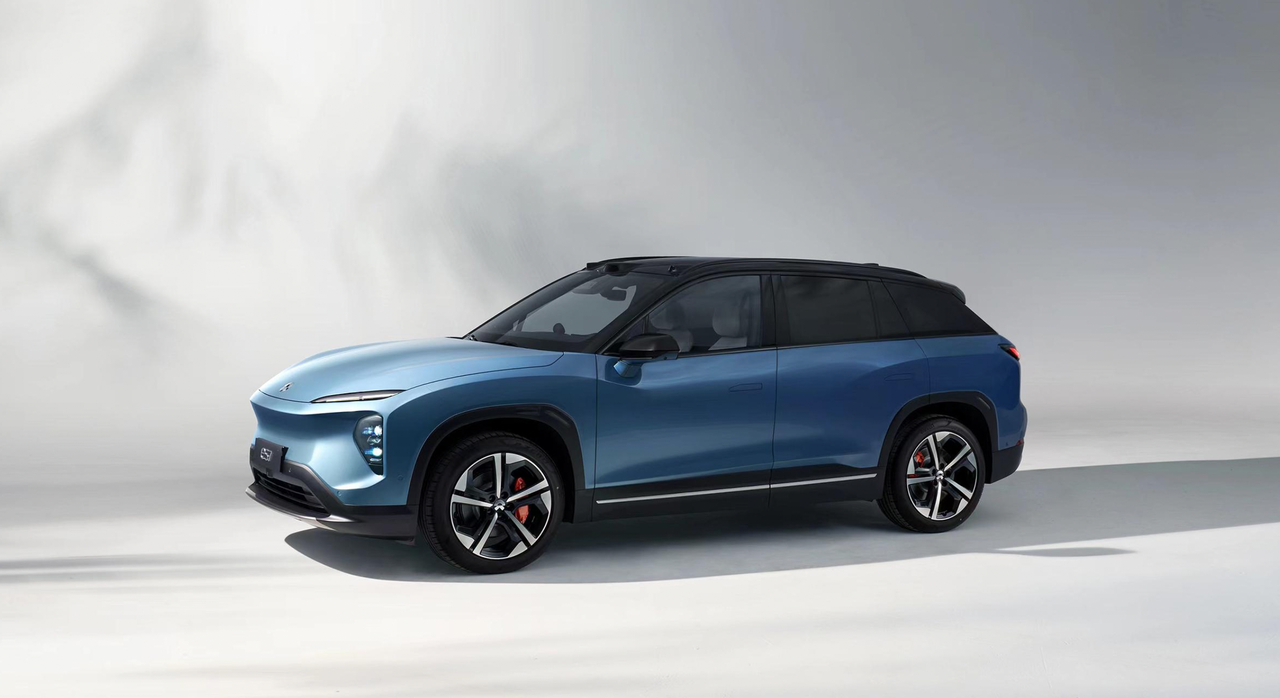
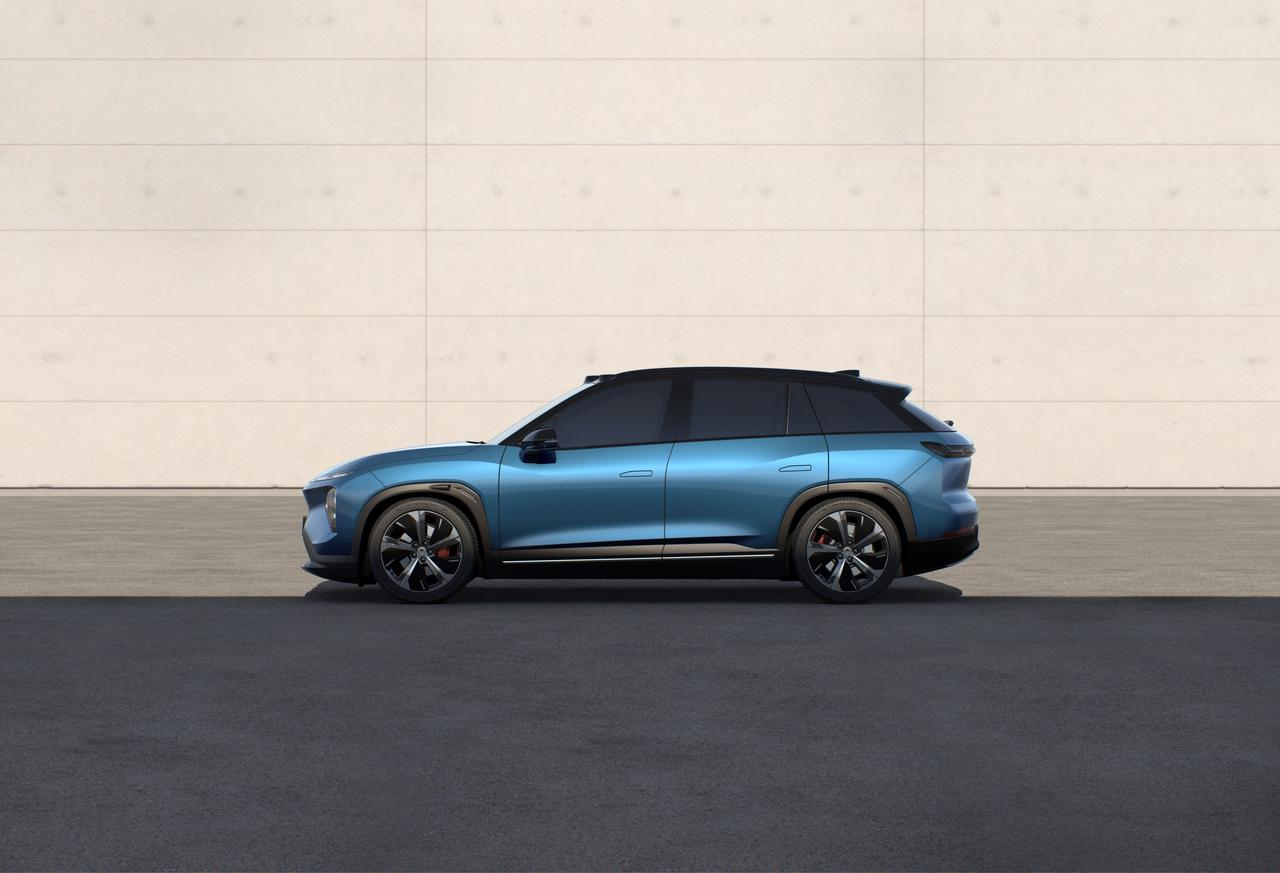

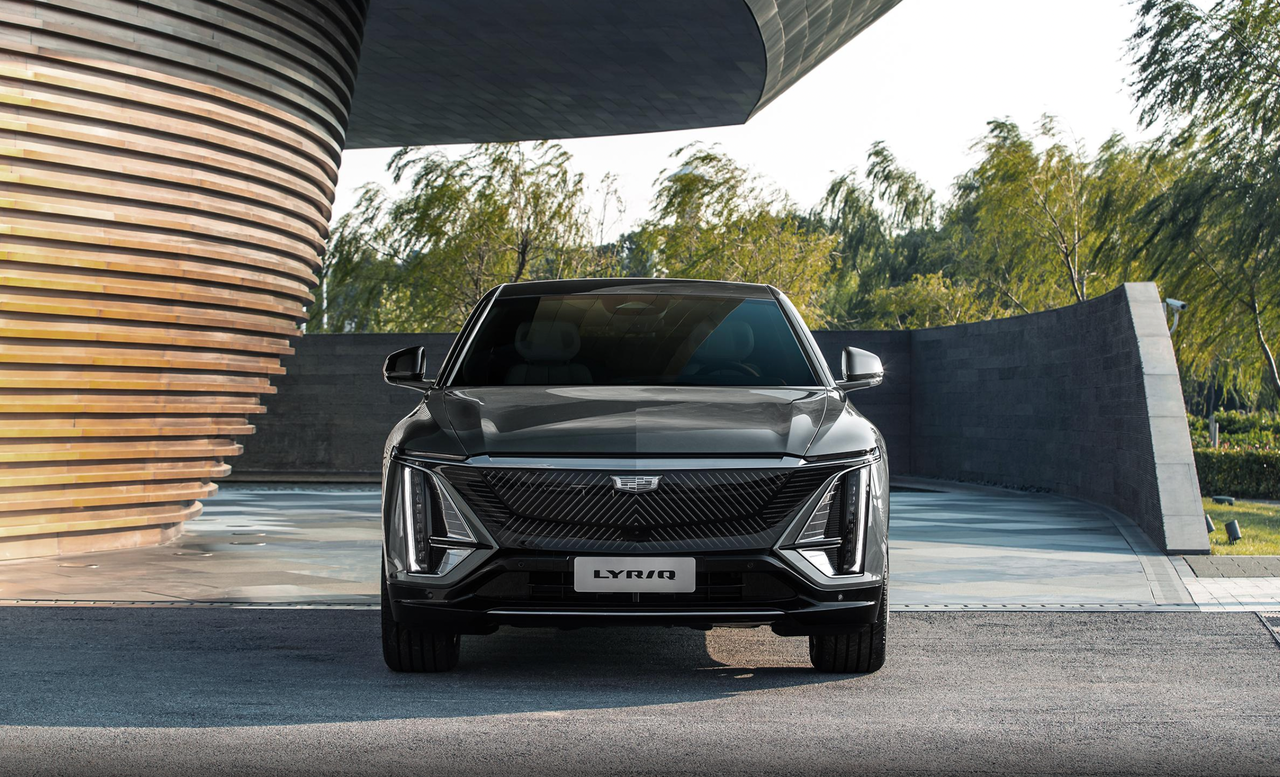
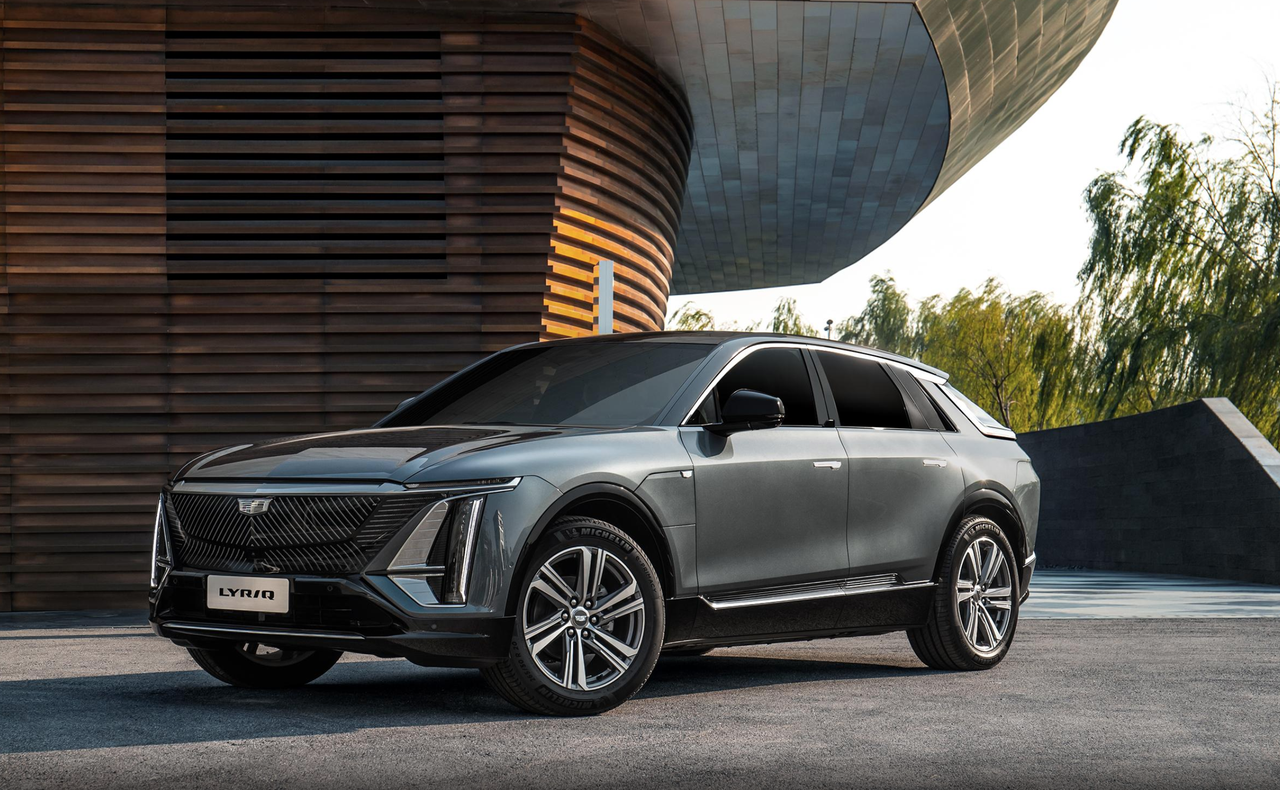
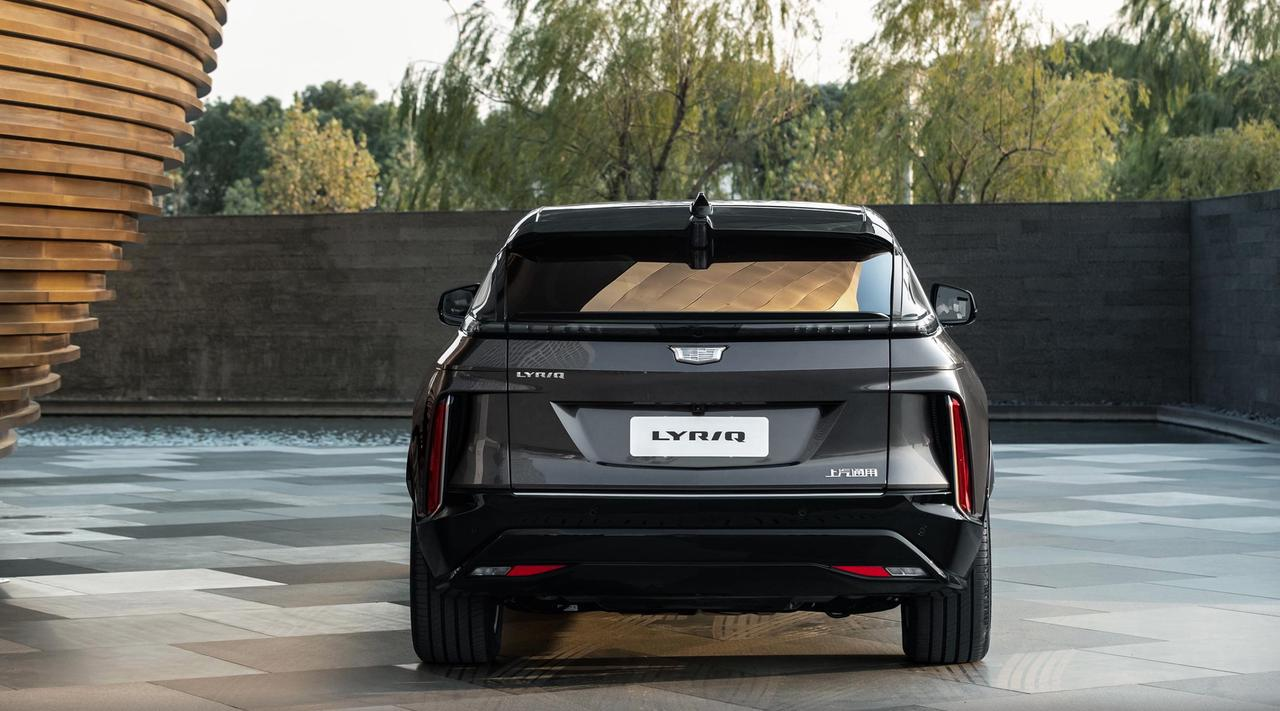

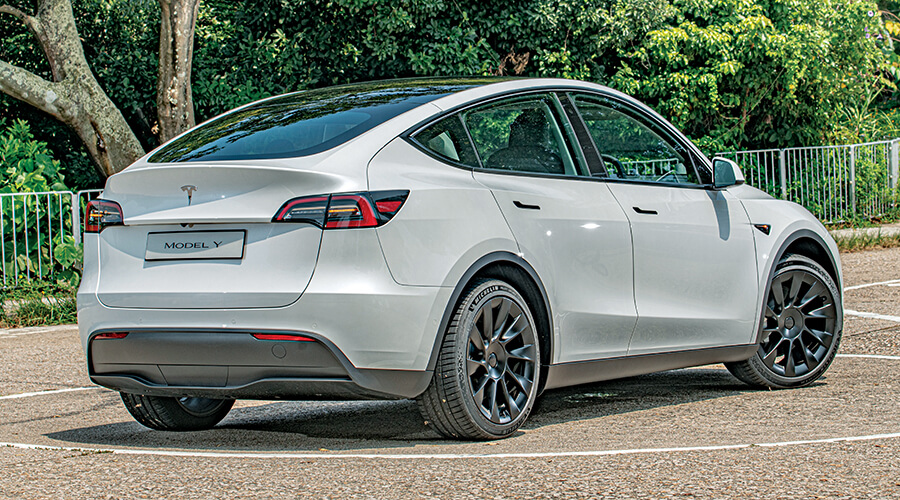
There is a point about the exterior design of the XPeng G9 that cannot be ignored, and that is the integration of sensors and vehicle body design.All of G9’s sensors are cleverly integrated into the car’s design. For example, two LIDARs are integrated below a pair of headlights, and the side cameras are integrated into the body trim, without any sense of abruptness or aggression.
Of course, this is also related to the layout of the sensors. In order to fully utilize the advantage of the “far-sightedness” of LIDAR, NIO lifts the LIDAR on the roof, which requires a certain degree of acceptance from users. The layout of XPeng, on the other hand, is somewhat easier in terms of design difficulties.
Based on this, we can also make a comparison with models that have the same sensor design layout.
NETA S also places the LIDAR below the headlights, with a seamless feel to the overall layout. In terms of industrial design, the layout that integrates with the headlights has a significantly lower design difficulty than the layout on the roof.
However, it should be noted that in the event of a collision or scraping, the plan to place the LIDAR below the headlights is obviously more likely to break than placing it on the roof, and the repair cost of LIDAR is quite high.
In terms of vehicle size, according to data from MIIT, G9’s body size is 4,891 x 1,937 x 1,670/1,680 mm (with optional air suspension height of 1670 mm) and a wheelbase of 2,998 mm. G9’s body length is 41 mm longer than that of NIO ES6 and 21 mm shorter than that of NIO ES7. Therefore, the actual size of G9, positioning it as a medium-sized five-seater, is not that large.
Although the body is not long, it has a wheelbase of nearly 3 meters. This inevitably reminds us of the fact that, although the P7’s wheelbase data is outstanding, it did not demonstrate an advantage in terms of car space. Does XPeng G9 still have such an old problem?
According to the declaration information, XPeng G9’s air suspension and LIDAR are not standard for the entire series. Does this indicate that there are also many segmented models of G9?
We all know that XPeng Automobile has always had the “old tradition” of making many segmented models based on configuration.On XPeng P5/P7, XPeng adopts the way of separately charging for assisted driving software and hardware. The suffix of the four types of vehicles, from high-end to low-end, is “P-E-N-G”, and users need to pay for hardware and software separately. To some extent, it provides rich choices for the diversified needs of consumers, but it also cuts off the user’s “regret” way.
It seems that XPeng wants to remove part of the “intelligent driving” from electric vehicles in today’s environment where intelligent driving users’ awareness is not mature and popularity is not high in order to gain more volume. However, this also leads to a large number of models for each single car of XPeng, which makes users feel overwhelmed.
This situation may change with the G9.
In the first quarter earnings conference call this year, XPeng Motors stated that although XPeng’s software charging business is doing very well among Chinese companies, “separate charging may not achieve the effect of unified charging.” And with the integration of intelligent cockpit and intelligent chassis, there is higher hardware and intelligent experience. Under such an integrated scheme, software charging is easier to be accepted, and a charging mechanism based on mileage or time may be introduced after the subsequent high-end intelligent driving has a better experience. At present, improving the penetration rate of intelligent driving is more important.
Even XPeng G9 does not rule out the strategy of optional hardware and standard software, but the impact on gross profit needs to be offset by adjusting equity.
Interpretation of the “Three Electrics”
On the Ministry of Industry and Information Technology’s catalogue, we were pleasantly surprised to find that the electric motor production enterprise name for some models of G9 was Guangzhou Zhipeng Manufacturing Co., Ltd., whose legal representative is Xia Heng, co-founder and CEO of XPeng Motors.
At the same time, the Ministry of Industry and Information Technology’s tax exemption catalogue shows that the single-motor version of XPeng G9 (rear-wheel drive 230 kW) has a power consumption of 15.2 kWh per 100 kilometers, while the four-wheel drive version (front 175 kW AC asynchronous motor, rear 230 kW permanent magnet synchronous motor) has a power consumption of 16 kWh per 100 kilometers. Both models are equipped with 98 kWh ternary lithium-ion battery packs, with a range of 702 km and 650 km, respectively.
By integrating these fragmented information, we can roughly know some basic information about the G9 models.After comparing with ES7 and other models, it was found that the 98 kWh battery pack used in G9 was almost the same in capacity as the 100 kWh battery pack used in ES7, but the cruising range was very outstanding. Even the single motor model exceeded 700 km. The brand new electric motor of NIO ES7 runs more “violently” with a total output power of 480 kW from the front and rear dual motors.
Although the performance of the single motor version of G9 seems not as dazzling in terms of power, its cruising ability is still very competitive among mid-to-large SUVs.
In addition, there are two new things worth mentioning in the exposed configurations.
Firstly, like NIO ES7, G9 has the ability to tow with a maximum towing weight of 1,500 kg. Camping has become a new entertainment and relaxation method in recent years, especially in the suburban areas. Electric vehicles have natural advantages in camping scenarios because they come with large batteries and do not need to worry about outdoor power supply. Even if you sleep in the car, you don’t have to worry about anything. However, when towing a trailer, the power consumption will increase significantly, resulting in reduced cruising range. At the same time, frequent energy replenishment will affect the ease of use of the trailer. However, no matter what, XPeng [Xpeng] will leave the choice to the users.
Another point is the “dual-chamber air spring“, which can predict road conditions in advance through sensing hardware and high-precision mapping, and adjust the suspension proactively. Ideal L9 and NIO ES7 both adopt a single-chamber air suspension system. Simply put, for a single-chamber air spring system, the height of the vehicle body can be adaptively adjusted. When the vehicle body height is different, the air pressure inside the airbag is different, thereby achieving different stiffness levels.
However, when the vehicle body height is kept in the same mode, the stiffness level is fixed and cannot be changed. Therefore, to achieve variable stiffness at a fixed height, an additional air chamber must be added.
Dual-chamber air suspension is more expensive in cost. Good “ingredients” are undoubtedly the basis for the performance of the chassis, but suspension methods, materials, and other factors are also closely related to it. The overall performance still depends on the tuning skills.
He XPeng revealed on Weibo that the chassis of the XPeng G9 was adjusted by a top German engineering team, which makes us more looking forward to the performance of the G9 when driving.
The above data is sufficient for a flagship car, but to support the title of “the flagship model of the new era of head power”, this car must be a benchmark model without any obvious shortcomings.
Let us go back to the day when it first appeared.# Small New G9 Is Unveiled as the First Model After Rebranding as the “Global Intelligent Flagship SUV”
When Small New G9 made its debut as the first model after its rebranding, the title given by Small New Auto was the “Global Intelligent Flagship SUV.” In the current period, when intelligent driving and intelligent cabins seem to have reached a bottleneck, our expectations for G9 are due to Small New’s continuous investment in intelligence technology. The word “flagship” requires not only outstanding fundamental data, but also advanced new technology.
Final Words
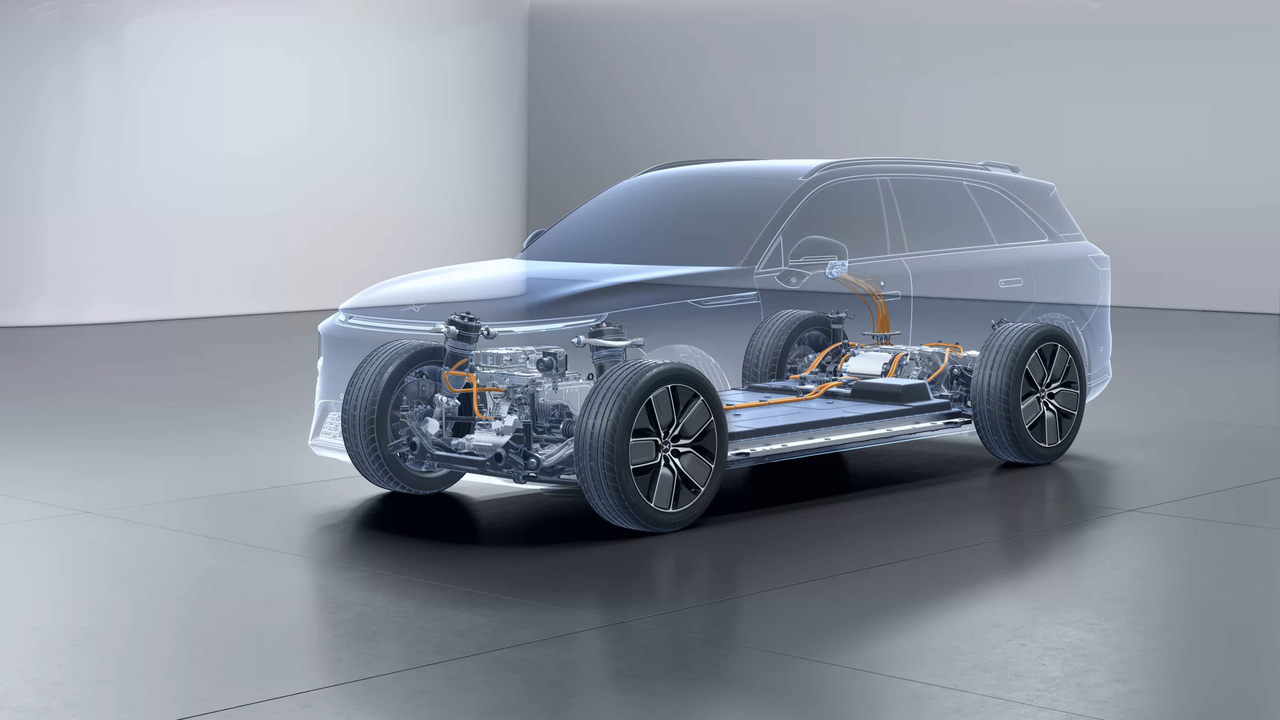
With the release of Ideal L9 and NIO ES7, our attitude towards Small New G9 is not just about offering more choices to the market, but with a lot more anticipation for its release. As a leading domestic car company in independent research of intelligent products, we hope that G9 will bring something revolutionary.
During one conversation with Small New Auto insiders, someone joked, “Sometimes I am afraid that our friends in the industry cannot keep up with us, but at the same time, if they catch up, it puts a lot of pressure on us.” After L9 and ES7 launched, we are keen to see the new things that G9 can provide to the industry and new choices to the users, just as P7 did before.
This article is a translation by ChatGPT of a Chinese report from 42HOW. If you have any questions about it, please email bd@42how.com.
